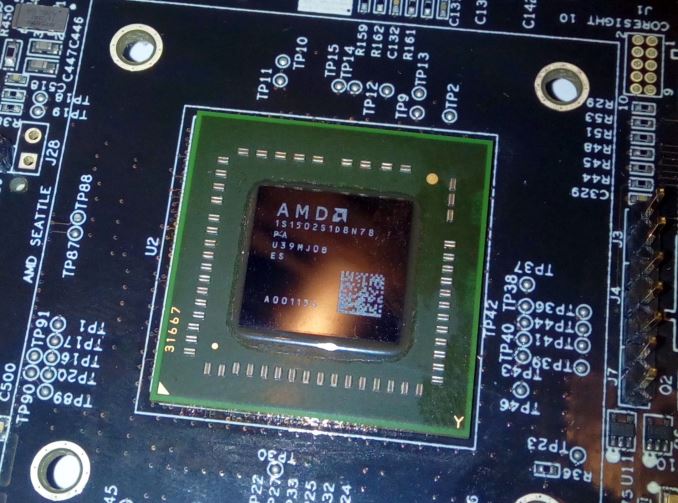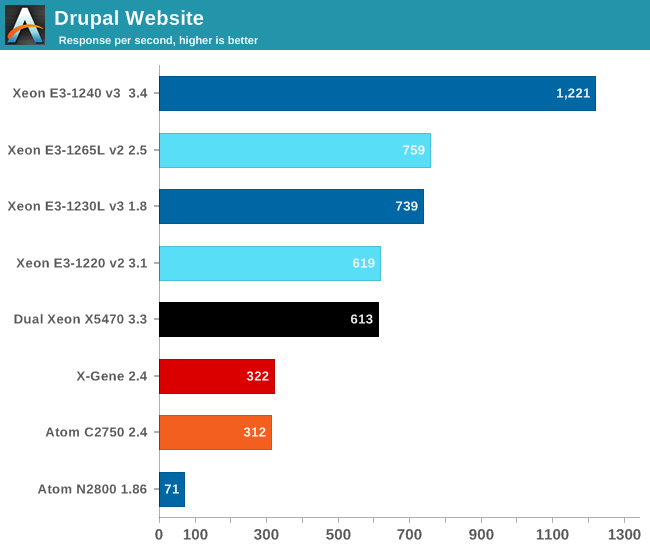The Silver Lining of the Late AMD Opteron A1100 Arrival
by Johan De Gelas on January 14, 2016 1:19 PM EST- Posted in
- Cloud Computing
- AMD
- Arm
- Opteron
- Opteron A1100

AMD announced their ARM server SoC plans at the end of 2012. At the beginning of 2014, AMD was ready "to accelerate the ARM Server Ecosystem with the first ARM-based server SoC" with a development kit. Around March 2014, the A1100 SoCs started sampling. But the quad core dev kits were not only expensive ($3000!), they also had quite a bit of teething problems as performance did not meet expectations, some of the peripheral hardware did not work properly, and the software ecosystem was far from ready. We were expecting to see Opteron A1100 based servers at the end of 2014, but instead we got more than a year of almost complete silence. Frustratingly long for anyone who was hoping that AMD would finally bring something competitive to the server world.
Today, AMD is finally announcing that their Octal core Opteron A1100 server SoC and platform is fully ready as "a right sized option for the edge of the datacenter". A few smaller partners are even shipping it. but there is no sign of tier 1 OEMs yet. Most people following this part of the semiconductor part are thinking "too little, too late". We are pretty sure that includes you, dear reader. But there is more than meets the eye or we would not bother to write this article.
Cards On the Table
AMD is launching 3 SKUs and the spec table is available below.
From the early reports, performance is somewhere between 80 to 90% of the Atom C2750 (Eight 2.4 GHz Silvermont cores at 2.4-2.6 GHz). Even if AMD has used the delay to tune the A1100 significantly, it is very unlikely that the chip will be able to beat the Atom chip by any tangible margin.
The performance per watt ratio of the 28 nm ARM Opteron is not stunning either: a TDP of 32W at 2 GHz is worse than the 20W that the 22 nm C2750 needs at 2.4 GHz. Of course, TDP is one thing, the real power consumption at low and medium loads is more important for a server SoC. Nevertheless, we were promised an octal core at Atom C2750 levels at 25W TDP.
And last but not least, the Atom has been available for more than 2 years now. Its successor, Denverton - or the 14 nm Atom C3xxx - should arrive in the second half of 2016. But Intel is late too, as Denverton was also supposed to be in the market by early 2015. Contrary to AMD however, is Intel executing very well in all other server markets. With the much less than hyped/predicted growth of the microserver market, it is only natural that Intel prioritize other products in its datacenter portefolio.
Overall the A1100's 32W TDP looks high and performance expectations are low, so why bother? Pricing perhaps? Unfortunately the answer to that will be "no," as AMD told us that the initial price of the A1170 SoC will be $150. That is the same price of the Atom C2730 (eight cores at 1.7 GHz), which will probably perform at the same level, but the Intel chip is a 12W TDP chip. At $150 the A1100 even comes dangerously close to the quad core, 8 thread Xeon D-1520 at 2.2 GHz ($199). Do not let the 4-cores fool you, we found that the octal core (16 thread) Xeon D-1540 is no less than 5.5 times faster than an Atom C2750 in real server workloads. Take a look below.

The A1100 will probably score around 300, the Xeon D-1520 will probably score beyond 600. So an Xeon D-1520 will still be at least twice as fast as an Atom C2750 or Opteron A1100. So the new AMD SoC has no performance/watt advantage and no price/performance advantage over Intel's offerings.











37 Comments
View All Comments
eldakka - Friday, January 15, 2016 - link
With 14 SATA ports, I wonder how this would perform as a ZFS-based NAS server?beginner99 - Friday, January 15, 2016 - link
True but you could just stick an expansion card into a Xeon-D server, if you need the CPU speed.beginner99 - Friday, January 15, 2016 - link
This thing probably sucks but that isn't surprising. I never ever got the micro server hype. It does also not make sense when you can run stuff on VMs on beefier CPUs and get better performance/watt and $.The_Assimilator - Friday, January 15, 2016 - link
"But there is more than meets the eye or we would not bother to write this article."And then at the end:
"So the new AMD SoC has no performance/watt advantage and no price/performance advantage over Intel's offerings."
AMD has failed, again.
Minion4Hire - Friday, January 15, 2016 - link
That's not the end. You have failed to read two entire pages if you think that is the end of the article.duploxxx - Friday, January 15, 2016 - link
no it does not suck. it is based on ARM while it is not fully comparable to a x86 socket.AMD had to release this socket on the default A57 to pave the road for there next gen k12 arm.
With this platform they are able to give initial go for drivers/support etc.
bill.rookard - Friday, January 15, 2016 - link
I would disagree with that comment about performance per watt. In certain fairly common use cases, such as a storage server compared to the C2000 series you would not only have to add a raid card to the Intel setup, but also provide for dual 10gb nic ports. Both of those cards will add both cost and wattage to the total overall system...Xeus32 - Friday, January 15, 2016 - link
Dear Anandtech,I'm very disappointed about this review.
I have from long time a Atom server and the basic concept of power consuming used in the standard review is not right when you are evaluating a system below 50W.
A single hard disk can consume from 5W (if you use low performance , high density disk ex: western digital red 2.5”) to 10W (if you use high performance hard disk).
We need also the RAM that for each bank have a power consumed more or less of 3W.
In my system ( ATOM with 2GB DDR2 RAM, LSI controller and 3 Hard disk 3.5” Raid 5) the power consumed of the only motherboard is around 35W and the hard disks have the same consumption. The power consume of the CPU is reported as 10W.
I don’t want speak about this processor but 40W or 20W is the same thing for me because if we add 4 hard disks to our hypothetical system, the power consumed from the storage is greater than the CPU.
JohanAnandtech - Saturday, January 16, 2016 - link
20W more or less per server node is a lot in a system like the HP Moonshot where have 40+ nodes in a high density system. It means that your 1 KW cluster now needs 1.8 KW.And I do make the point that it less of an issue in a storage rich system and that AMD might have a chance there.
mosu - Friday, January 15, 2016 - link
So an upgrade to A72, 14nm and USB 3.0 or 3.1 with actual SATA and PCI will make a great chip someday, now that the road was opened.Maybe a 16 core A72 will do even better...